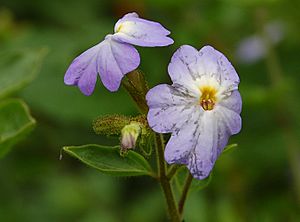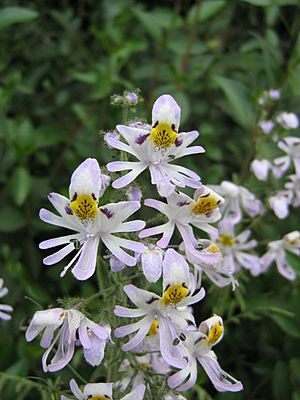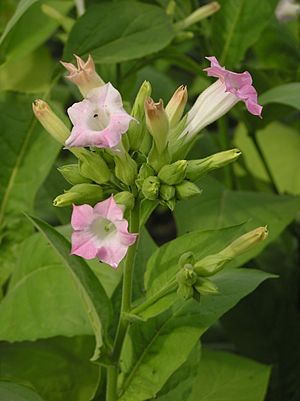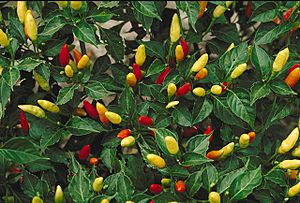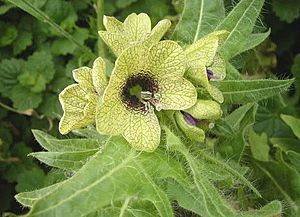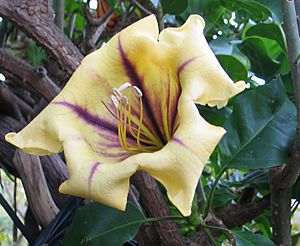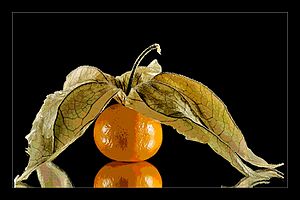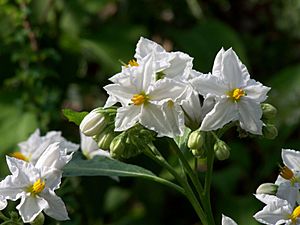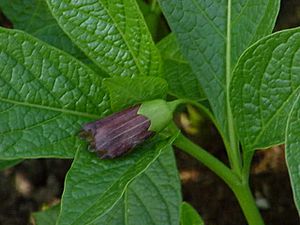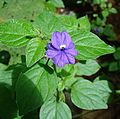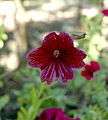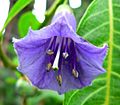Nightshade facts for kids
Quick facts for kids Solanaceae |
|
|---|---|
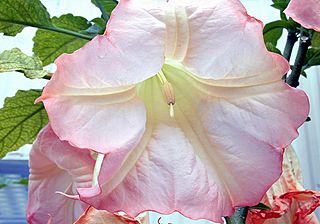 |
|
| A flowering Brugmansia x insignis from the US Botanic Garden |
|
| Scientific classification | |
| Kingdom: | |
| Division: | |
| Class: | |
| Order: | |
| Family: |
Solanaceae
|
The nightshades (Solanaceae) are a large family of plants. All of them have flowers. Many plants in this family are edible, meaning you can eat them. However, some parts of other nightshade plants can be poisonous. Often, only certain parts of a plant are safe to eat, while other parts are not.
Some well-known members of the nightshade family include chili peppers, petunias, deadly nightshade, mandrakes, potatoes, tomatoes, aubergines (eggplants), and tobacco. Some people believe that eating nightshades can cause or increase swelling and pain, so they choose not to eat them.
Contents
What are Nightshades?
The nightshade family is very diverse. It includes many different types of plants, from small herbs to large trees. Scientists group these plants into smaller categories called subfamilies and tribes. This helps them understand how the plants are related to each other. These groups are based on how the plants look and their genetic makeup.
Cestroideae (Browallioideae)
This group of nightshades has special fibers in their stems. They usually have four or five stamens (the parts of a flower that make pollen). The plants in this group are mostly found in North and South America. The genus Cestrum is the largest, with about 175 species. Many of these plants are shrubs.
- Browallia is a genus with six species. They grow from the warmer parts of America up to Arizona in the United States.
- Cestrum includes many species found across the Americas.
- Salpiglossis has two species from southern South America.
Goetzeoideae
This subfamily is known for having fruits called drupes. These are fleshy fruits with a hard pit inside, like a peach. Their seeds have curved embryos. These plants are found in the Greater Antilles, which are islands in the Caribbean Sea.
- Goetzea includes two species from the Antilles.
Petunioideae
This group of plants is closely related to the Solanoideae and Nicotianoideae subfamilies. They often have four stamens, sometimes five, and they can be different lengths. These plants are found throughout Central and South America.
- Brunfelsia has about 45 species from the warmer parts of America.
- Fabiana includes 15 species that grow in the Andes mountains.
- Nierembergia has 21 species from South America.
- Calibrachoa and Petunia are two well-known genera in this group. They look similar, but scientists keep them separate because of differences in their chromosomes. Calibrachoa has 32 species, and Petunia has 18 species, both from South America.
Schizanthoideae
Plants in this group are usually annual or biennial, meaning they live for one or two years. Their flowers are often unique, with a special shape that is not perfectly symmetrical. They have two stamens and three stamen-like structures that don't produce pollen. Their fruits are capsules, which open to release seeds that are spread by the wind.
- Schizanthus is the main genus here, with 12 species from Chile. This genus is a bit unusual among nightshades because of its flower shape and chromosome number. Scientists believe it separated from the rest of the nightshade family a very long time ago, about 50 million years ago. The many different flower types in Schizanthus helped them adapt to different pollinators in their environment.
Schwenckioideae
These are annual plants with special fibers in their stems. Their flowers are also not perfectly symmetrical. They have four stamens or three stamen-like structures. These plants are found throughout South America.
- Schwenckia is the largest genus in this group, with 22 species found in the warmer parts of America.
Nicotianoideae
This subfamily includes plants mostly found in Australia and America.
- The Anthocercideae tribe is found only in Australia. It has 31 species across seven genera.
- The Nicotianeae tribe includes the famous genus Nicotiana.
Solanoideae

This is a very large and important subfamily of nightshades. It includes many plants we use every day.
- The Capsiceae tribe includes:
- Capsicum, which is the genus for all chili peppers and bell peppers. It has 40 species from the Americas.
- The Datureae tribe includes:
- Brugmansia, with six tree species from the Andes mountains.
- Datura, with 12 species from the Americas.
- The Hyoscyameae tribe includes:
- Atropa, which has four species from Europe and Asia, including the famous deadly nightshade.
- Hyoscyamus, with 10 species from the Mediterranean to China.
- The Physaleae tribe is a large group. It includes many plants with interesting fruits.
- The Iochrominae group has 37 species, mostly from the Andes. These are often woody shrubs or small trees with colorful, tube-shaped flowers. Their flowers can be red, orange, yellow, green, blue, purple, or white.
- Acnistus has one species found in the warmer parts of America.
- Iochroma has 24 species from the Andes.
- The Physalinae group includes herbs or woody shrubs. They have yellow, white, or purple flowers. After pollination, the flower's calyx (the outer leaf-like part) grows to cover the developing fruit. This calyx often turns yellow or orange when the fruit is ripe. The fruits are berries with many seeds.
- Physalis is the largest genus in this group, with 85 species. This includes plants like the Cape gooseberry.
- The Iochrominae group has 37 species, mostly from the Andes. These are often woody shrubs or small trees with colorful, tube-shaped flowers. Their flowers can be red, orange, yellow, green, blue, purple, or white.
- The Tribe Solaneae includes the largest genus in the entire nightshade family:
Images for kids
-
Fruits including tomatoes, tomatillos, eggplant, bell peppers and chili peppers, all of which are closely related members of the Solanaceae.
-
Illustration of Solanum dulcamara, 1.- Flower, 2.- Flower in longitudinal section, without the petals; 3.- Androecium; 4.- Ovary, in transverse section; 5.- Seed viewed from above; 6.- Seed in transverse section, note the curved embryo surrounding the endosperm; A.- Branch with leaves and flowers; B.- Stem with immature and mature fruit
-
Streptosolen jamesonii, Cultivated plant, Chelsea Physic Garden London UK.
-
Goetzea elegans ( subfamily Goetzeoideae ) in bud and flower, South Miami, Florida United States.
-
Atropa belladonna ( Deadly Nightshade ) flower
-
Eriolarynx australis ( known formerly as Iochroma australe ) flower, cultivated plant, UBC Botanical Garden, British Columbia.
-
Triple-flowered Datura metel 'Fastuosa': ancient cultivar created from Datura innoxia by Pre-Columbian horticulturalists in the Greater Antilles
See also
 In Spanish: Solanáceas para niños
In Spanish: Solanáceas para niños



